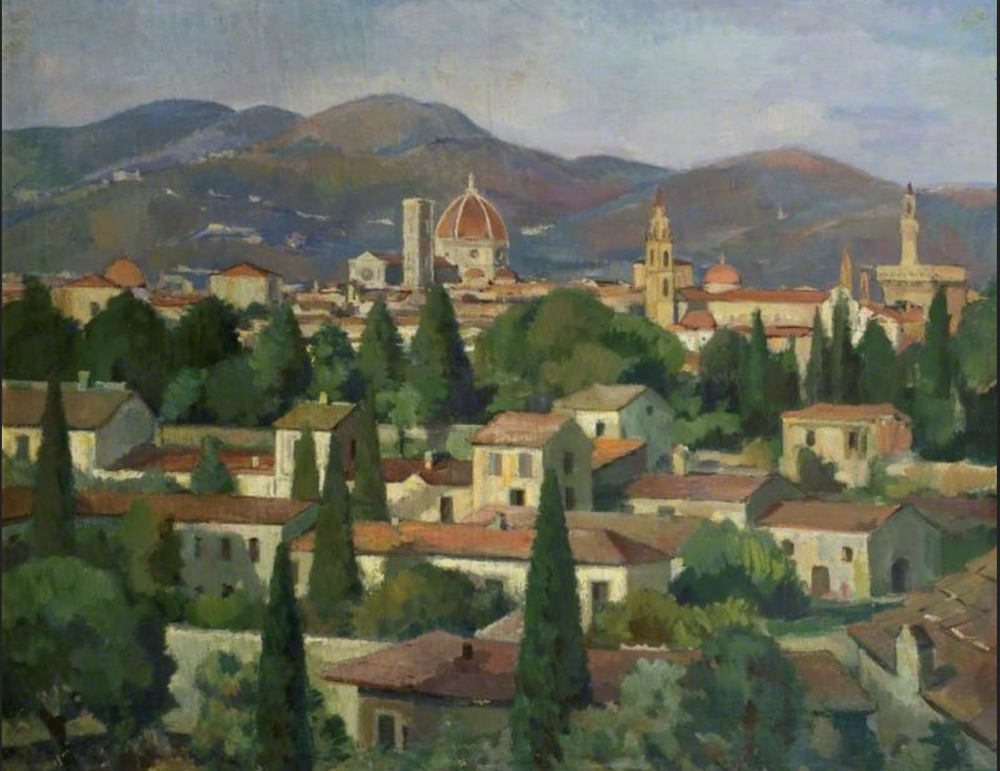Hitchin, the Hertfordshire town where we’ve lived for the past twenty years or so, is remarkable in having been home to three reasonably well-known twentieth-century artists. Two of them, Theodor Kern (1900 – 1969) and Gerard Ceunis (1885- 1964) – whose possible connections with Kern I wrote about here, and who is the subject of another of my blogs – were emigrés who found refuge in this modest market town, Kern fleeing from Nazi-occupied Austria and Ceunis escaping war-torn Belgium. Despite their foreign origins, both men chose to spend the greater part of their lives in Hitchin, and both of them died and are buried here.

Site of the Griggs family bakery, High Street, Hitchin (via http://www.google.co.uk/maps)
The third artist, the etcher and illustrator Frederick Landseer Griggs (1876 – 1938), was born and grew up in the town but spent the latter part of his life elsewhere. Griggs came from a family of Baptist shopkeepers. His father kept a bakery in Hitchin High Street (the site is currently vacant – see above) directly opposite Perks and Llewellyn’s pharmacy, whose front door would later be adorned with stained glass created by Theodor Kern.

F. L. Griggs, ‘St Ippolyts’, 1927
Griggs attended a variety of local schools, but also had private drawing lessons from men like the watercolourist Samuel Lucas the younger, a member of a prominent – and artistic – Quaker family in the town. Much of Griggs’ work reflects his upbringing in Hitchin, as well as his long walks in the surrounding countryside, and features many familiar local landmarks, including a beautiful etching of our own village church in St Ippolyts, to the south of the town. The principal influence on his art was Samuel Palmer, and it can be argued that his visionary work stands in a tradition reaching back through Palmer to William Blake, and forward to Graham Sutherland and John Piper. There are also occasional affinities, to my untrained eye, with the work of the Catholic painter-poet David Jones, whose connections with Theodor Kern I explored in a recent post.
To my shame, I hadn’t heard the name of F.L. Griggs until a touring exhibition of his work arrived in Hitchin from the Ashmolean Museum in 2017. I was immediately taken with his work, and bought a copy of the sumptuous biography, written by Jerrold Northrop Moore, the biographer of Edward Elgar, and published in handsome coffee-table format with a generous helping of illustrations.

The most important thing that Griggs shared in common with Kern was his devout Catholicism. It’s perhaps ironic that these two men, who are arguably among the most significant British-based Catholic artists of the last century, lived in a town with such a proud Nonconformist heritage. As I’ve related elsewhere, Theodor Kern was born into a nominal Catholic family in Salzburg but experienced a religious conversion in his early thirties. Griggs, by contrast – like me – was born into a resolutely Nonconformist family but converted to Catholicism as an adult. He was received into the Church in 1912, befriending Fr Adrian Fortescue, the parish priest in neighbouring Letchworth, who was an antiquarian, scholar and adventurer with interests similar to Griggs’ own. Interestingly, it was a later priest of the same parish who first took Theodor Kern under his wing when he arrived in the area during the Second World War.
F.L. Griggs eventually moved to Chipping Campden in the Cotswolds, where he was associated with the Guild of Handicrafts and came under the influence of the Arts and Crafts Movement. His relationship with his home town was ambivalent, to say the least. According to his friend, the Hitchin lawyer and historian Reginald Hine (also a close friend of Gerard Ceunis), Griggs once described Bancroft, the wide road that runs through the middle of Hitchin, as one of the most beautiful streets in England, but grew to dislike the modern ‘improvements’ to the town, which he came to speak of as ‘dear detestable Hitchin’ [1].

F. L. Griggs, ‘Sarras’

Theodor Kern, untitled/unfinished painting, probably of a Sicilian town, 1930s (?) (Smith collection)
Frederick Landseer Griggs died a year before Theodor Kern arrived in England, so they would have been unaware of each other’s existence. Identifying points of connection between the works of these two artists is difficult. In a way Griggs, whose drawings illustrated many of the ‘Highways and Byways’ series of books devoted to English counties, had more in common with Gerard Ceunis, who performed a similar role for Reginald Hine’s history of Hitchin. Griggs was primarily a draughtsman, interested in the way buildings reflected a shared (and threatened) history and culture, and there is little space in his elaborate etchings for natural features, or indeed for people, except for a few stylised medieval figures. Kern, by contrast, was primarily a landscape painter and an accomplished portraitist whose interest in the human form is also reflected in his many religious sculptures, carvings and stained glass windows. The built environment certainly features in many of Kern’s landscapes, and he too is a skilled draughtsman, but one gets the impression that it is the subjective impression of a building or townscape on the viewer, rather than the precise delineation of its objective features, still less what it represents historically or culturally, that interests the Austrian-born artist.
Nevertheless, it remains a remarkable fact that our modest market town was home to these two fascinating twentieth-century Catholic artists, both of whose work deserves to be much better known.
1. Reginald Hine (1951) ‘The life and art-work of F.L.Griggs, R.A.’, in Relics of an Un-common Attorney, London: Dent & Sons.
